Research Proposal: System Failure Impact on CBA Productivity
VerifiedAdded on 2022/09/30
|13
|2726
|17
Project
AI Summary
This research proposal investigates the impact of system failures on the productivity of the Commonwealth Bank of Australia (CBA). It begins with an introduction outlining the purpose, scope, and background of the problem, including specific instances of system failures affecting employees and customers, such as issues with insurance, superannuation, and money laundering. The proposal defines the problem and provides a literature review covering relevant research on information technology in the banking sector, the importance of technology investment, and the impact of IT failures. The research design employs a mixed-methods approach, using an explanatory research design with both quantitative and qualitative data collection methods. The specific methods include surveys with closed-ended questions and semi-structured interviews. The sampling strategy involves simple random sampling of 300 employees. Data analysis will be conducted using SPSS for quantitative data and content analysis for qualitative data. The proposal also addresses ethical considerations, including informed consent and data integrity. Finally, it includes a budget and timeline for the research project.
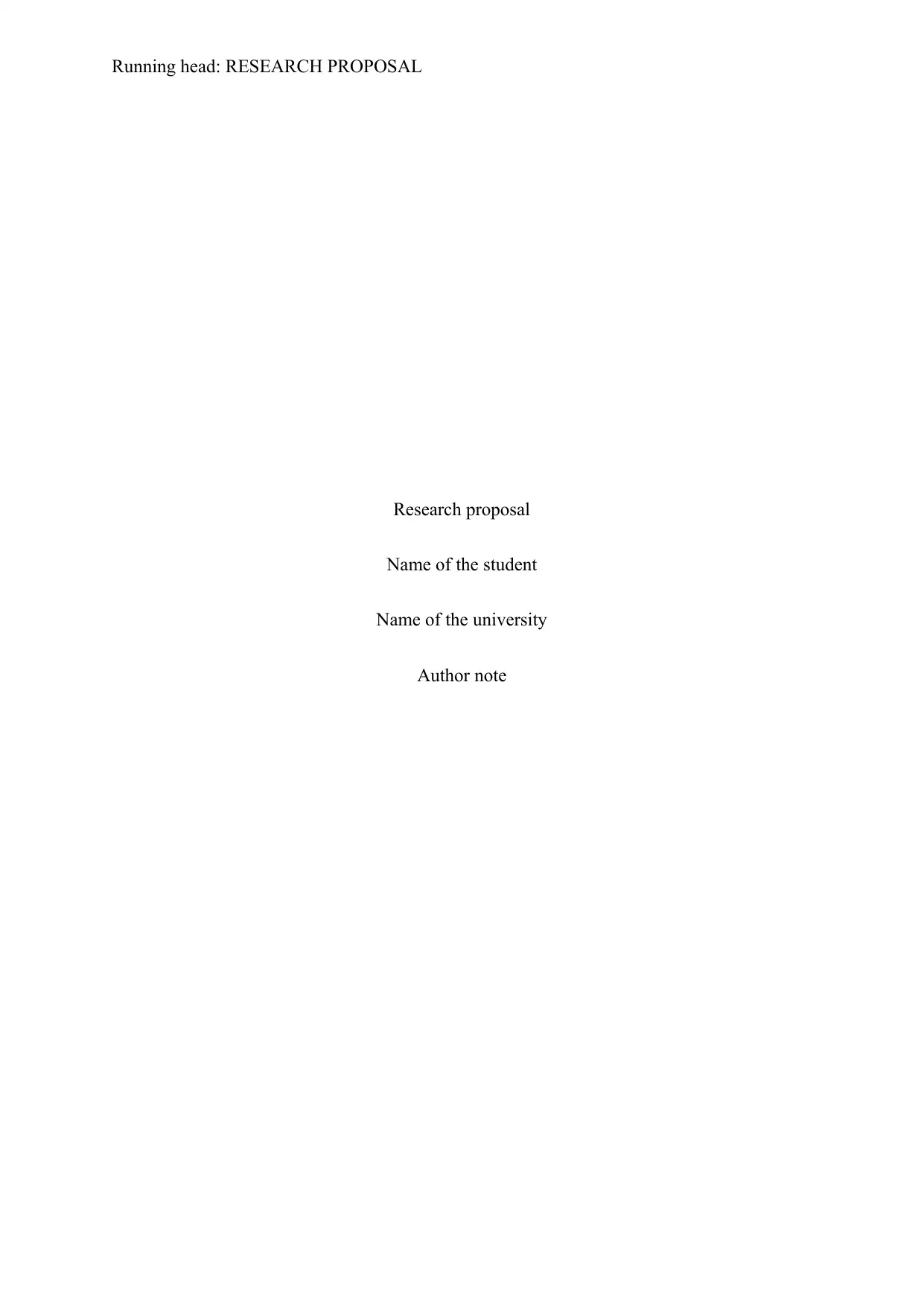
Running head: RESEARCH PROPOSAL
Research proposal
Name of the student
Name of the university
Author note
Research proposal
Name of the student
Name of the university
Author note
Paraphrase This Document
Need a fresh take? Get an instant paraphrase of this document with our AI Paraphraser
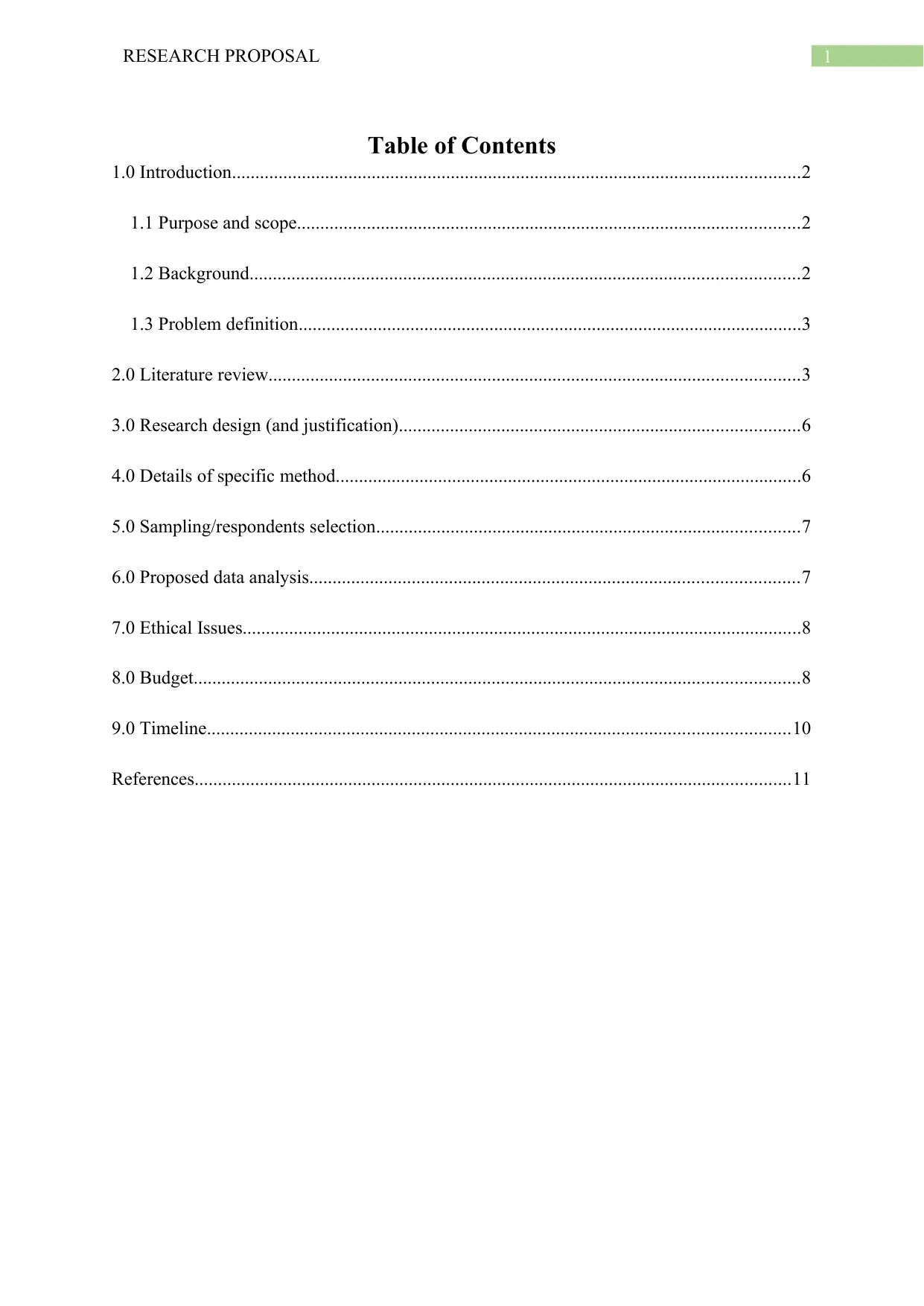
1RESEARCH PROPOSAL
Table of Contents
1.0 Introduction..........................................................................................................................2
1.1 Purpose and scope............................................................................................................2
1.2 Background......................................................................................................................2
1.3 Problem definition............................................................................................................3
2.0 Literature review..................................................................................................................3
3.0 Research design (and justification)......................................................................................6
4.0 Details of specific method....................................................................................................6
5.0 Sampling/respondents selection...........................................................................................7
6.0 Proposed data analysis.........................................................................................................7
7.0 Ethical Issues........................................................................................................................8
8.0 Budget..................................................................................................................................8
9.0 Timeline.............................................................................................................................10
References................................................................................................................................11
Table of Contents
1.0 Introduction..........................................................................................................................2
1.1 Purpose and scope............................................................................................................2
1.2 Background......................................................................................................................2
1.3 Problem definition............................................................................................................3
2.0 Literature review..................................................................................................................3
3.0 Research design (and justification)......................................................................................6
4.0 Details of specific method....................................................................................................6
5.0 Sampling/respondents selection...........................................................................................7
6.0 Proposed data analysis.........................................................................................................7
7.0 Ethical Issues........................................................................................................................8
8.0 Budget..................................................................................................................................8
9.0 Timeline.............................................................................................................................10
References................................................................................................................................11
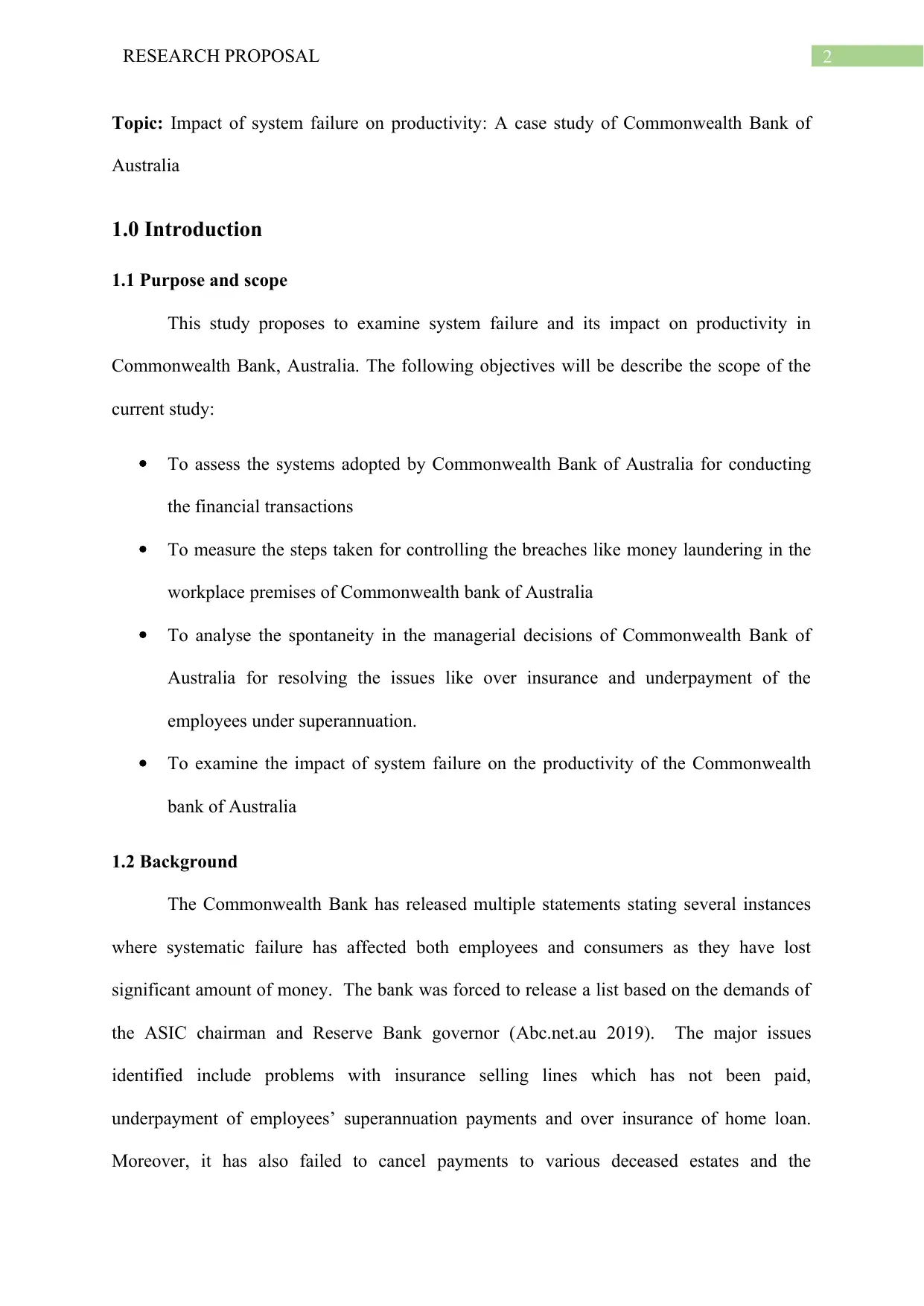
2RESEARCH PROPOSAL
Topic: Impact of system failure on productivity: A case study of Commonwealth Bank of
Australia
1.0 Introduction
1.1 Purpose and scope
This study proposes to examine system failure and its impact on productivity in
Commonwealth Bank, Australia. The following objectives will be describe the scope of the
current study:
To assess the systems adopted by Commonwealth Bank of Australia for conducting
the financial transactions
To measure the steps taken for controlling the breaches like money laundering in the
workplace premises of Commonwealth bank of Australia
To analyse the spontaneity in the managerial decisions of Commonwealth Bank of
Australia for resolving the issues like over insurance and underpayment of the
employees under superannuation.
To examine the impact of system failure on the productivity of the Commonwealth
bank of Australia
1.2 Background
The Commonwealth Bank has released multiple statements stating several instances
where systematic failure has affected both employees and consumers as they have lost
significant amount of money. The bank was forced to release a list based on the demands of
the ASIC chairman and Reserve Bank governor (Abc.net.au 2019). The major issues
identified include problems with insurance selling lines which has not been paid,
underpayment of employees’ superannuation payments and over insurance of home loan.
Moreover, it has also failed to cancel payments to various deceased estates and the
Topic: Impact of system failure on productivity: A case study of Commonwealth Bank of
Australia
1.0 Introduction
1.1 Purpose and scope
This study proposes to examine system failure and its impact on productivity in
Commonwealth Bank, Australia. The following objectives will be describe the scope of the
current study:
To assess the systems adopted by Commonwealth Bank of Australia for conducting
the financial transactions
To measure the steps taken for controlling the breaches like money laundering in the
workplace premises of Commonwealth bank of Australia
To analyse the spontaneity in the managerial decisions of Commonwealth Bank of
Australia for resolving the issues like over insurance and underpayment of the
employees under superannuation.
To examine the impact of system failure on the productivity of the Commonwealth
bank of Australia
1.2 Background
The Commonwealth Bank has released multiple statements stating several instances
where systematic failure has affected both employees and consumers as they have lost
significant amount of money. The bank was forced to release a list based on the demands of
the ASIC chairman and Reserve Bank governor (Abc.net.au 2019). The major issues
identified include problems with insurance selling lines which has not been paid,
underpayment of employees’ superannuation payments and over insurance of home loan.
Moreover, it has also failed to cancel payments to various deceased estates and the
⊘ This is a preview!⊘
Do you want full access?
Subscribe today to unlock all pages.

Trusted by 1+ million students worldwide
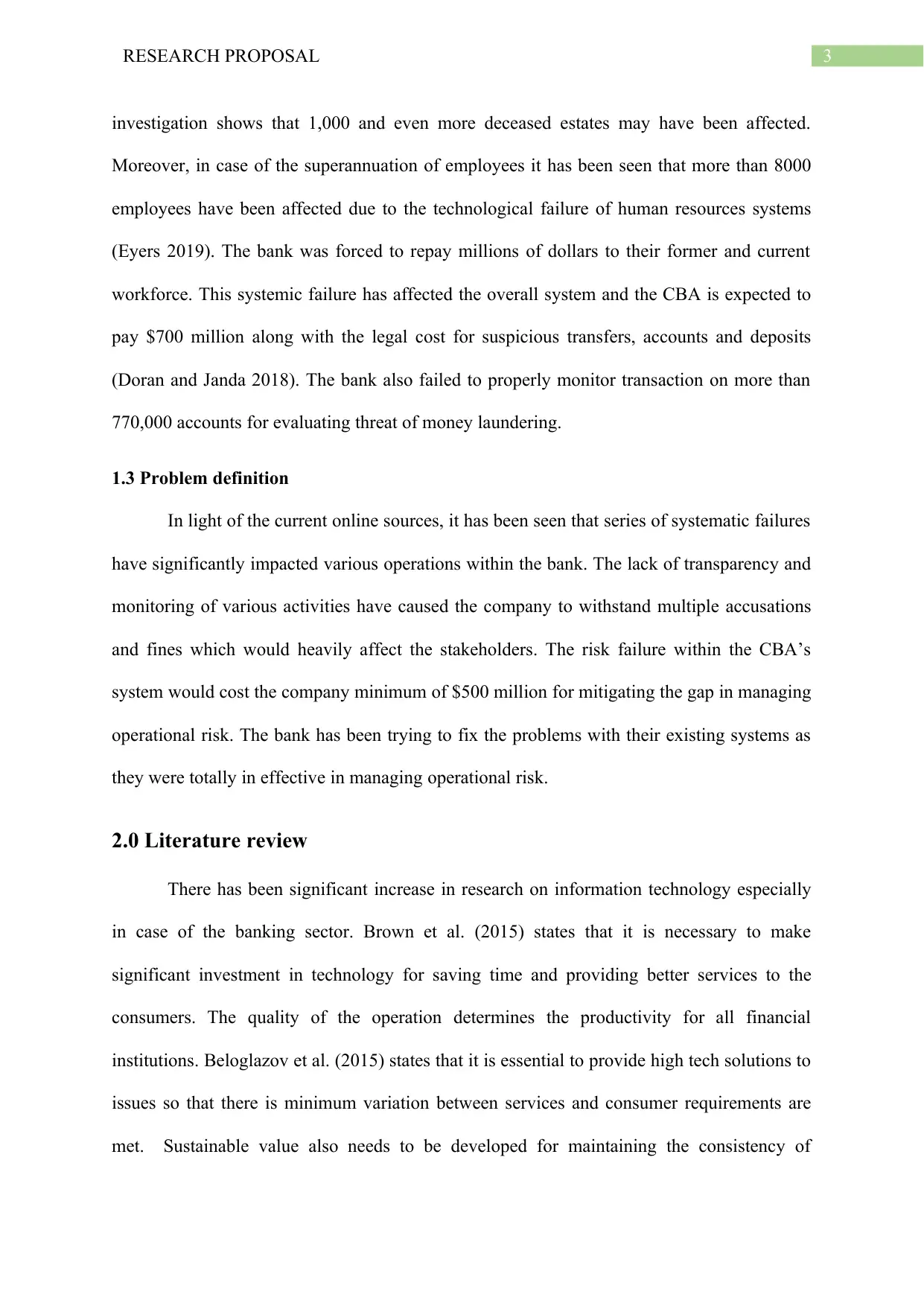
3RESEARCH PROPOSAL
investigation shows that 1,000 and even more deceased estates may have been affected.
Moreover, in case of the superannuation of employees it has been seen that more than 8000
employees have been affected due to the technological failure of human resources systems
(Eyers 2019). The bank was forced to repay millions of dollars to their former and current
workforce. This systemic failure has affected the overall system and the CBA is expected to
pay $700 million along with the legal cost for suspicious transfers, accounts and deposits
(Doran and Janda 2018). The bank also failed to properly monitor transaction on more than
770,000 accounts for evaluating threat of money laundering.
1.3 Problem definition
In light of the current online sources, it has been seen that series of systematic failures
have significantly impacted various operations within the bank. The lack of transparency and
monitoring of various activities have caused the company to withstand multiple accusations
and fines which would heavily affect the stakeholders. The risk failure within the CBA’s
system would cost the company minimum of $500 million for mitigating the gap in managing
operational risk. The bank has been trying to fix the problems with their existing systems as
they were totally in effective in managing operational risk.
2.0 Literature review
There has been significant increase in research on information technology especially
in case of the banking sector. Brown et al. (2015) states that it is necessary to make
significant investment in technology for saving time and providing better services to the
consumers. The quality of the operation determines the productivity for all financial
institutions. Beloglazov et al. (2015) states that it is essential to provide high tech solutions to
issues so that there is minimum variation between services and consumer requirements are
met. Sustainable value also needs to be developed for maintaining the consistency of
investigation shows that 1,000 and even more deceased estates may have been affected.
Moreover, in case of the superannuation of employees it has been seen that more than 8000
employees have been affected due to the technological failure of human resources systems
(Eyers 2019). The bank was forced to repay millions of dollars to their former and current
workforce. This systemic failure has affected the overall system and the CBA is expected to
pay $700 million along with the legal cost for suspicious transfers, accounts and deposits
(Doran and Janda 2018). The bank also failed to properly monitor transaction on more than
770,000 accounts for evaluating threat of money laundering.
1.3 Problem definition
In light of the current online sources, it has been seen that series of systematic failures
have significantly impacted various operations within the bank. The lack of transparency and
monitoring of various activities have caused the company to withstand multiple accusations
and fines which would heavily affect the stakeholders. The risk failure within the CBA’s
system would cost the company minimum of $500 million for mitigating the gap in managing
operational risk. The bank has been trying to fix the problems with their existing systems as
they were totally in effective in managing operational risk.
2.0 Literature review
There has been significant increase in research on information technology especially
in case of the banking sector. Brown et al. (2015) states that it is necessary to make
significant investment in technology for saving time and providing better services to the
consumers. The quality of the operation determines the productivity for all financial
institutions. Beloglazov et al. (2015) states that it is essential to provide high tech solutions to
issues so that there is minimum variation between services and consumer requirements are
met. Sustainable value also needs to be developed for maintaining the consistency of
Paraphrase This Document
Need a fresh take? Get an instant paraphrase of this document with our AI Paraphraser
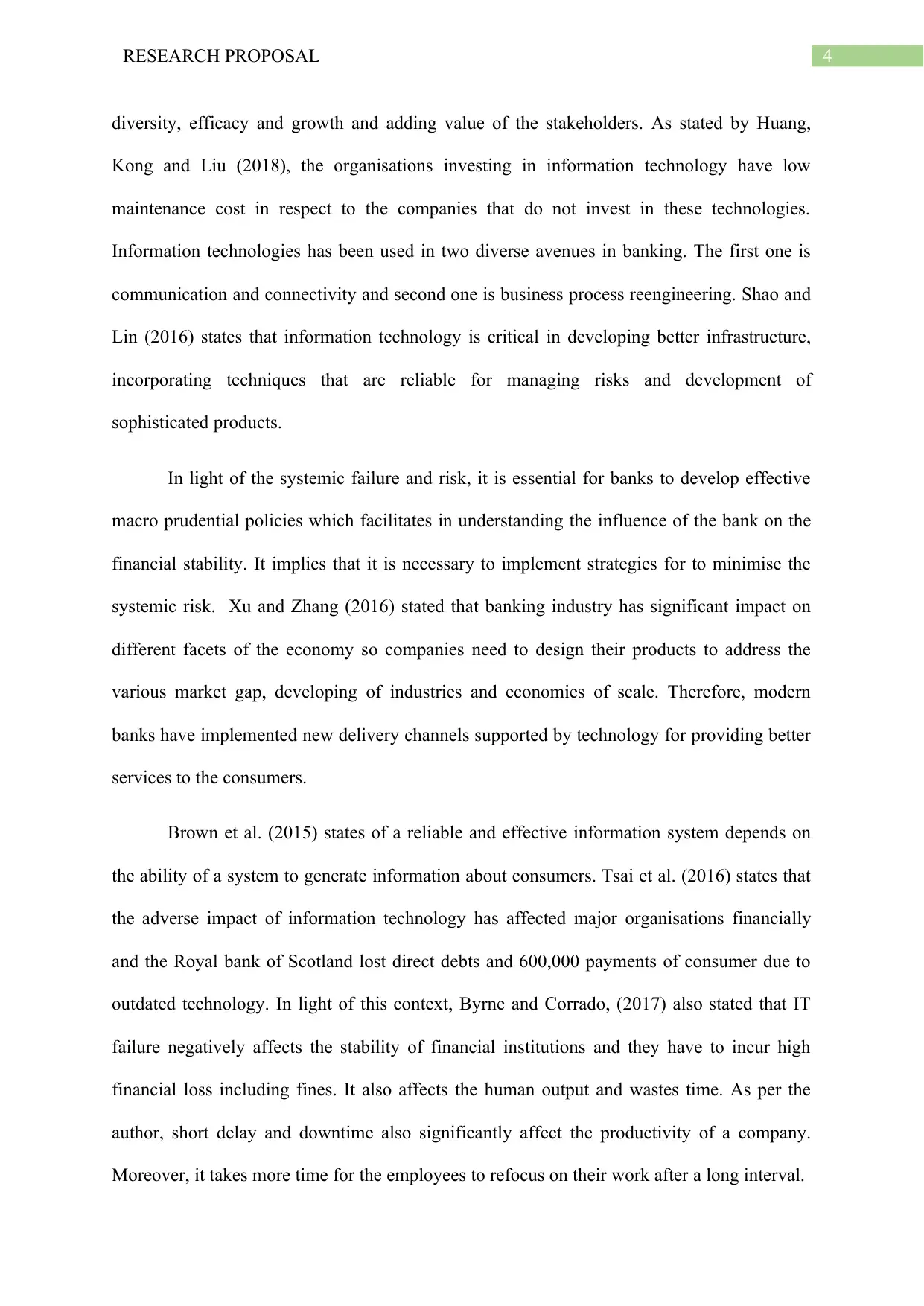
4RESEARCH PROPOSAL
diversity, efficacy and growth and adding value of the stakeholders. As stated by Huang,
Kong and Liu (2018), the organisations investing in information technology have low
maintenance cost in respect to the companies that do not invest in these technologies.
Information technologies has been used in two diverse avenues in banking. The first one is
communication and connectivity and second one is business process reengineering. Shao and
Lin (2016) states that information technology is critical in developing better infrastructure,
incorporating techniques that are reliable for managing risks and development of
sophisticated products.
In light of the systemic failure and risk, it is essential for banks to develop effective
macro prudential policies which facilitates in understanding the influence of the bank on the
financial stability. It implies that it is necessary to implement strategies for to minimise the
systemic risk. Xu and Zhang (2016) stated that banking industry has significant impact on
different facets of the economy so companies need to design their products to address the
various market gap, developing of industries and economies of scale. Therefore, modern
banks have implemented new delivery channels supported by technology for providing better
services to the consumers.
Brown et al. (2015) states of a reliable and effective information system depends on
the ability of a system to generate information about consumers. Tsai et al. (2016) states that
the adverse impact of information technology has affected major organisations financially
and the Royal bank of Scotland lost direct debts and 600,000 payments of consumer due to
outdated technology. In light of this context, Byrne and Corrado, (2017) also stated that IT
failure negatively affects the stability of financial institutions and they have to incur high
financial loss including fines. It also affects the human output and wastes time. As per the
author, short delay and downtime also significantly affect the productivity of a company.
Moreover, it takes more time for the employees to refocus on their work after a long interval.
diversity, efficacy and growth and adding value of the stakeholders. As stated by Huang,
Kong and Liu (2018), the organisations investing in information technology have low
maintenance cost in respect to the companies that do not invest in these technologies.
Information technologies has been used in two diverse avenues in banking. The first one is
communication and connectivity and second one is business process reengineering. Shao and
Lin (2016) states that information technology is critical in developing better infrastructure,
incorporating techniques that are reliable for managing risks and development of
sophisticated products.
In light of the systemic failure and risk, it is essential for banks to develop effective
macro prudential policies which facilitates in understanding the influence of the bank on the
financial stability. It implies that it is necessary to implement strategies for to minimise the
systemic risk. Xu and Zhang (2016) stated that banking industry has significant impact on
different facets of the economy so companies need to design their products to address the
various market gap, developing of industries and economies of scale. Therefore, modern
banks have implemented new delivery channels supported by technology for providing better
services to the consumers.
Brown et al. (2015) states of a reliable and effective information system depends on
the ability of a system to generate information about consumers. Tsai et al. (2016) states that
the adverse impact of information technology has affected major organisations financially
and the Royal bank of Scotland lost direct debts and 600,000 payments of consumer due to
outdated technology. In light of this context, Byrne and Corrado, (2017) also stated that IT
failure negatively affects the stability of financial institutions and they have to incur high
financial loss including fines. It also affects the human output and wastes time. As per the
author, short delay and downtime also significantly affect the productivity of a company.
Moreover, it takes more time for the employees to refocus on their work after a long interval.
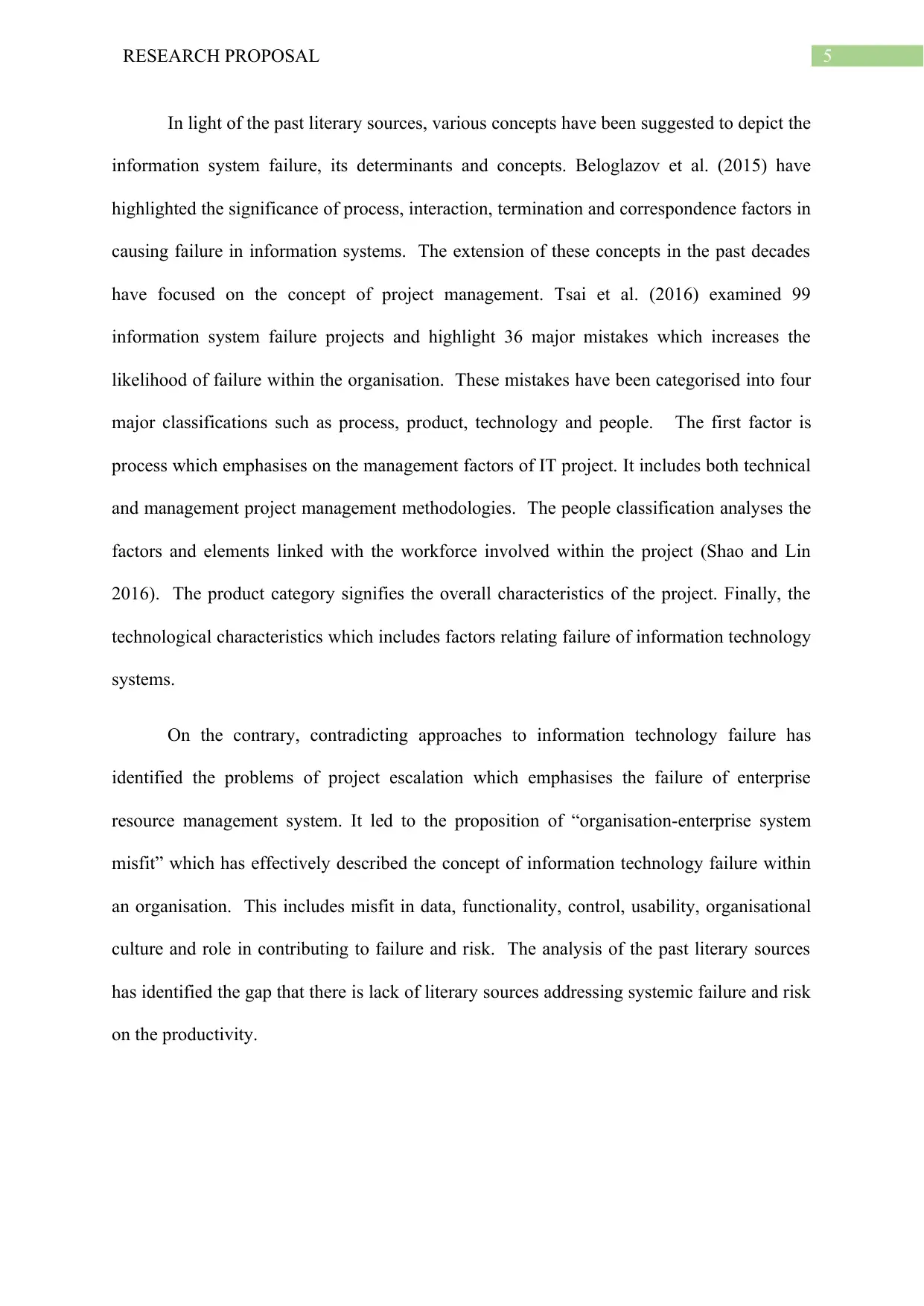
5RESEARCH PROPOSAL
In light of the past literary sources, various concepts have been suggested to depict the
information system failure, its determinants and concepts. Beloglazov et al. (2015) have
highlighted the significance of process, interaction, termination and correspondence factors in
causing failure in information systems. The extension of these concepts in the past decades
have focused on the concept of project management. Tsai et al. (2016) examined 99
information system failure projects and highlight 36 major mistakes which increases the
likelihood of failure within the organisation. These mistakes have been categorised into four
major classifications such as process, product, technology and people. The first factor is
process which emphasises on the management factors of IT project. It includes both technical
and management project management methodologies. The people classification analyses the
factors and elements linked with the workforce involved within the project (Shao and Lin
2016). The product category signifies the overall characteristics of the project. Finally, the
technological characteristics which includes factors relating failure of information technology
systems.
On the contrary, contradicting approaches to information technology failure has
identified the problems of project escalation which emphasises the failure of enterprise
resource management system. It led to the proposition of “organisation-enterprise system
misfit” which has effectively described the concept of information technology failure within
an organisation. This includes misfit in data, functionality, control, usability, organisational
culture and role in contributing to failure and risk. The analysis of the past literary sources
has identified the gap that there is lack of literary sources addressing systemic failure and risk
on the productivity.
In light of the past literary sources, various concepts have been suggested to depict the
information system failure, its determinants and concepts. Beloglazov et al. (2015) have
highlighted the significance of process, interaction, termination and correspondence factors in
causing failure in information systems. The extension of these concepts in the past decades
have focused on the concept of project management. Tsai et al. (2016) examined 99
information system failure projects and highlight 36 major mistakes which increases the
likelihood of failure within the organisation. These mistakes have been categorised into four
major classifications such as process, product, technology and people. The first factor is
process which emphasises on the management factors of IT project. It includes both technical
and management project management methodologies. The people classification analyses the
factors and elements linked with the workforce involved within the project (Shao and Lin
2016). The product category signifies the overall characteristics of the project. Finally, the
technological characteristics which includes factors relating failure of information technology
systems.
On the contrary, contradicting approaches to information technology failure has
identified the problems of project escalation which emphasises the failure of enterprise
resource management system. It led to the proposition of “organisation-enterprise system
misfit” which has effectively described the concept of information technology failure within
an organisation. This includes misfit in data, functionality, control, usability, organisational
culture and role in contributing to failure and risk. The analysis of the past literary sources
has identified the gap that there is lack of literary sources addressing systemic failure and risk
on the productivity.
⊘ This is a preview!⊘
Do you want full access?
Subscribe today to unlock all pages.

Trusted by 1+ million students worldwide
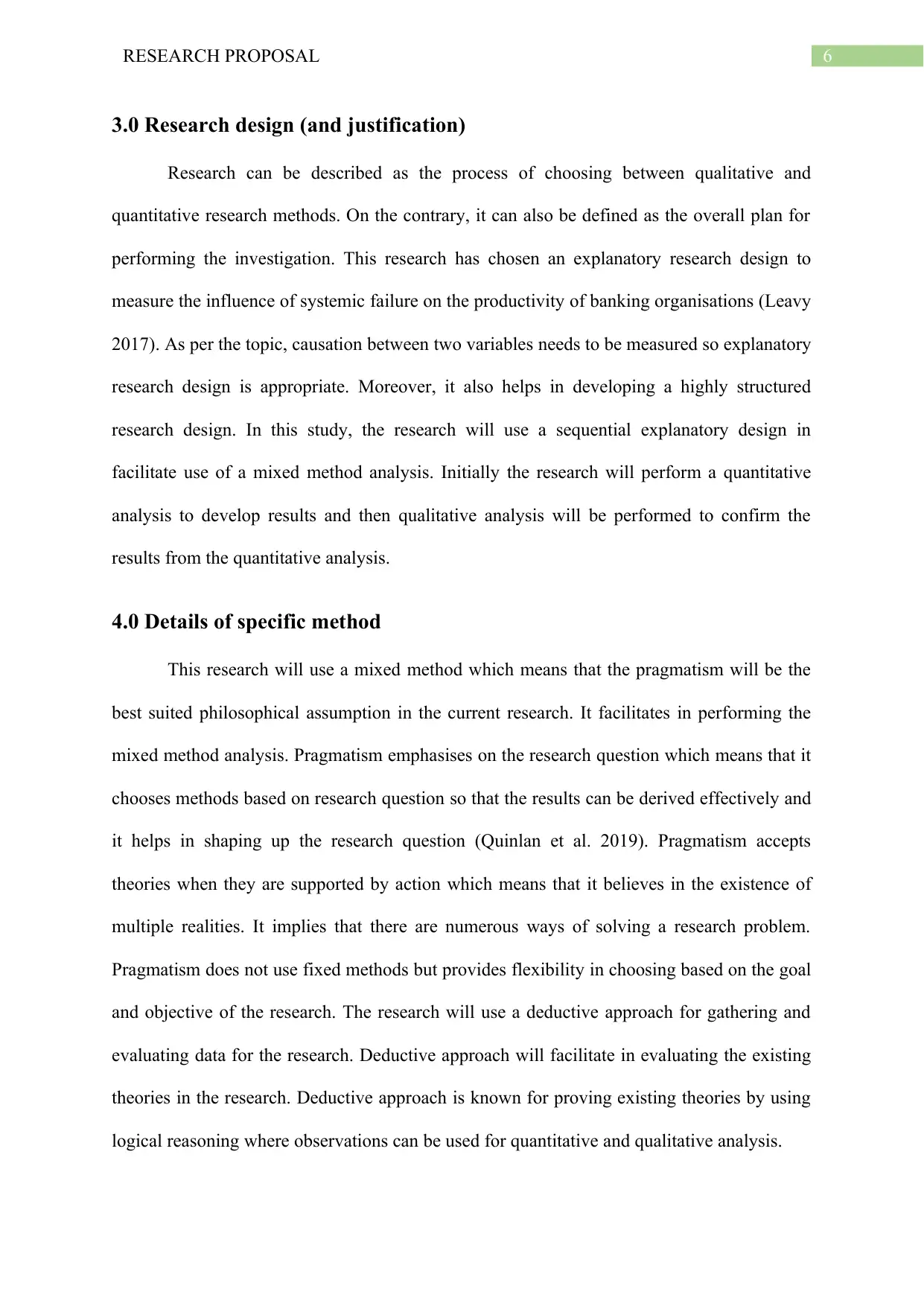
6RESEARCH PROPOSAL
3.0 Research design (and justification)
Research can be described as the process of choosing between qualitative and
quantitative research methods. On the contrary, it can also be defined as the overall plan for
performing the investigation. This research has chosen an explanatory research design to
measure the influence of systemic failure on the productivity of banking organisations (Leavy
2017). As per the topic, causation between two variables needs to be measured so explanatory
research design is appropriate. Moreover, it also helps in developing a highly structured
research design. In this study, the research will use a sequential explanatory design in
facilitate use of a mixed method analysis. Initially the research will perform a quantitative
analysis to develop results and then qualitative analysis will be performed to confirm the
results from the quantitative analysis.
4.0 Details of specific method
This research will use a mixed method which means that the pragmatism will be the
best suited philosophical assumption in the current research. It facilitates in performing the
mixed method analysis. Pragmatism emphasises on the research question which means that it
chooses methods based on research question so that the results can be derived effectively and
it helps in shaping up the research question (Quinlan et al. 2019). Pragmatism accepts
theories when they are supported by action which means that it believes in the existence of
multiple realities. It implies that there are numerous ways of solving a research problem.
Pragmatism does not use fixed methods but provides flexibility in choosing based on the goal
and objective of the research. The research will use a deductive approach for gathering and
evaluating data for the research. Deductive approach will facilitate in evaluating the existing
theories in the research. Deductive approach is known for proving existing theories by using
logical reasoning where observations can be used for quantitative and qualitative analysis.
3.0 Research design (and justification)
Research can be described as the process of choosing between qualitative and
quantitative research methods. On the contrary, it can also be defined as the overall plan for
performing the investigation. This research has chosen an explanatory research design to
measure the influence of systemic failure on the productivity of banking organisations (Leavy
2017). As per the topic, causation between two variables needs to be measured so explanatory
research design is appropriate. Moreover, it also helps in developing a highly structured
research design. In this study, the research will use a sequential explanatory design in
facilitate use of a mixed method analysis. Initially the research will perform a quantitative
analysis to develop results and then qualitative analysis will be performed to confirm the
results from the quantitative analysis.
4.0 Details of specific method
This research will use a mixed method which means that the pragmatism will be the
best suited philosophical assumption in the current research. It facilitates in performing the
mixed method analysis. Pragmatism emphasises on the research question which means that it
chooses methods based on research question so that the results can be derived effectively and
it helps in shaping up the research question (Quinlan et al. 2019). Pragmatism accepts
theories when they are supported by action which means that it believes in the existence of
multiple realities. It implies that there are numerous ways of solving a research problem.
Pragmatism does not use fixed methods but provides flexibility in choosing based on the goal
and objective of the research. The research will use a deductive approach for gathering and
evaluating data for the research. Deductive approach will facilitate in evaluating the existing
theories in the research. Deductive approach is known for proving existing theories by using
logical reasoning where observations can be used for quantitative and qualitative analysis.
Paraphrase This Document
Need a fresh take? Get an instant paraphrase of this document with our AI Paraphraser
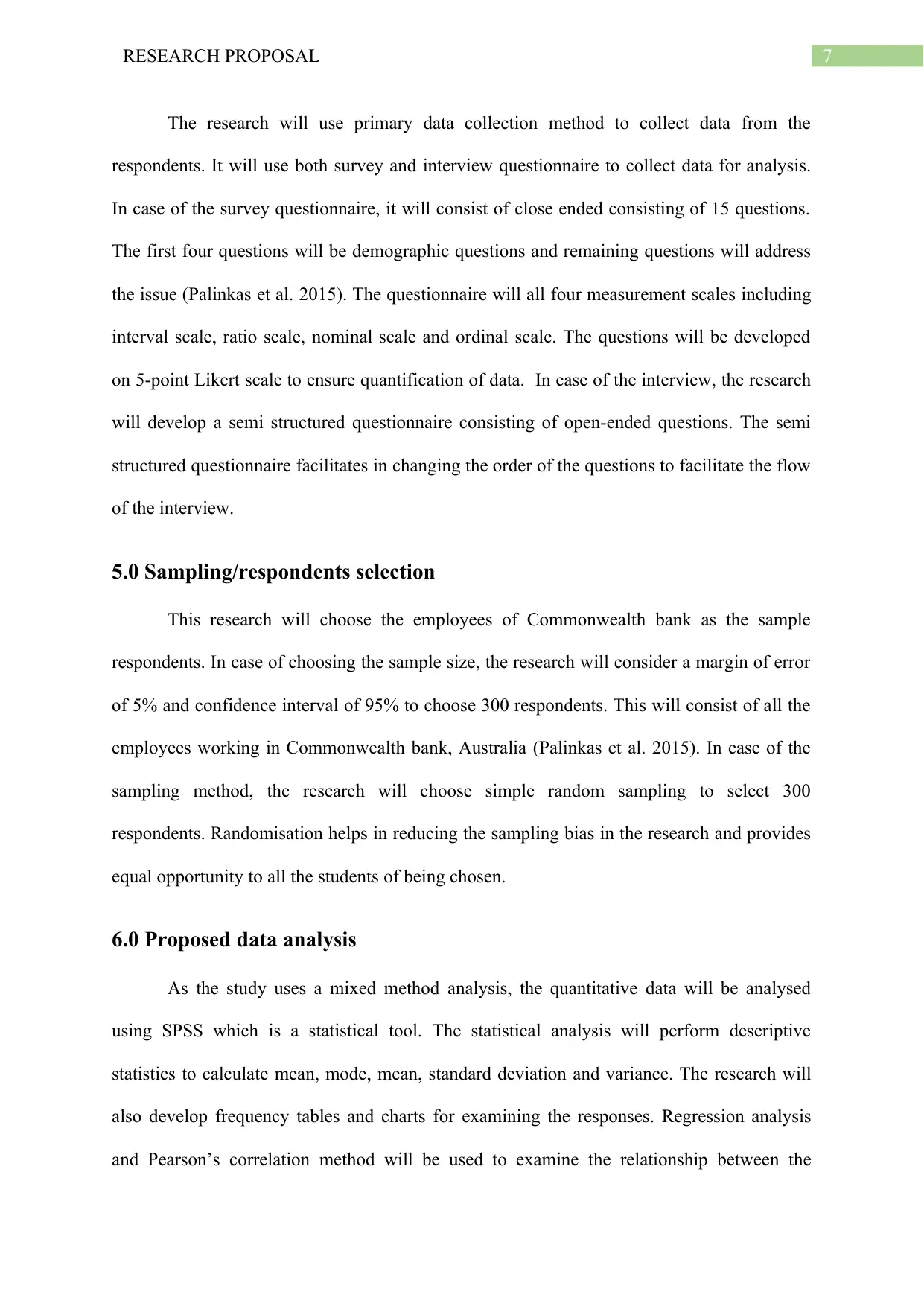
7RESEARCH PROPOSAL
The research will use primary data collection method to collect data from the
respondents. It will use both survey and interview questionnaire to collect data for analysis.
In case of the survey questionnaire, it will consist of close ended consisting of 15 questions.
The first four questions will be demographic questions and remaining questions will address
the issue (Palinkas et al. 2015). The questionnaire will all four measurement scales including
interval scale, ratio scale, nominal scale and ordinal scale. The questions will be developed
on 5-point Likert scale to ensure quantification of data. In case of the interview, the research
will develop a semi structured questionnaire consisting of open-ended questions. The semi
structured questionnaire facilitates in changing the order of the questions to facilitate the flow
of the interview.
5.0 Sampling/respondents selection
This research will choose the employees of Commonwealth bank as the sample
respondents. In case of choosing the sample size, the research will consider a margin of error
of 5% and confidence interval of 95% to choose 300 respondents. This will consist of all the
employees working in Commonwealth bank, Australia (Palinkas et al. 2015). In case of the
sampling method, the research will choose simple random sampling to select 300
respondents. Randomisation helps in reducing the sampling bias in the research and provides
equal opportunity to all the students of being chosen.
6.0 Proposed data analysis
As the study uses a mixed method analysis, the quantitative data will be analysed
using SPSS which is a statistical tool. The statistical analysis will perform descriptive
statistics to calculate mean, mode, mean, standard deviation and variance. The research will
also develop frequency tables and charts for examining the responses. Regression analysis
and Pearson’s correlation method will be used to examine the relationship between the
The research will use primary data collection method to collect data from the
respondents. It will use both survey and interview questionnaire to collect data for analysis.
In case of the survey questionnaire, it will consist of close ended consisting of 15 questions.
The first four questions will be demographic questions and remaining questions will address
the issue (Palinkas et al. 2015). The questionnaire will all four measurement scales including
interval scale, ratio scale, nominal scale and ordinal scale. The questions will be developed
on 5-point Likert scale to ensure quantification of data. In case of the interview, the research
will develop a semi structured questionnaire consisting of open-ended questions. The semi
structured questionnaire facilitates in changing the order of the questions to facilitate the flow
of the interview.
5.0 Sampling/respondents selection
This research will choose the employees of Commonwealth bank as the sample
respondents. In case of choosing the sample size, the research will consider a margin of error
of 5% and confidence interval of 95% to choose 300 respondents. This will consist of all the
employees working in Commonwealth bank, Australia (Palinkas et al. 2015). In case of the
sampling method, the research will choose simple random sampling to select 300
respondents. Randomisation helps in reducing the sampling bias in the research and provides
equal opportunity to all the students of being chosen.
6.0 Proposed data analysis
As the study uses a mixed method analysis, the quantitative data will be analysed
using SPSS which is a statistical tool. The statistical analysis will perform descriptive
statistics to calculate mean, mode, mean, standard deviation and variance. The research will
also develop frequency tables and charts for examining the responses. Regression analysis
and Pearson’s correlation method will be used to examine the relationship between the
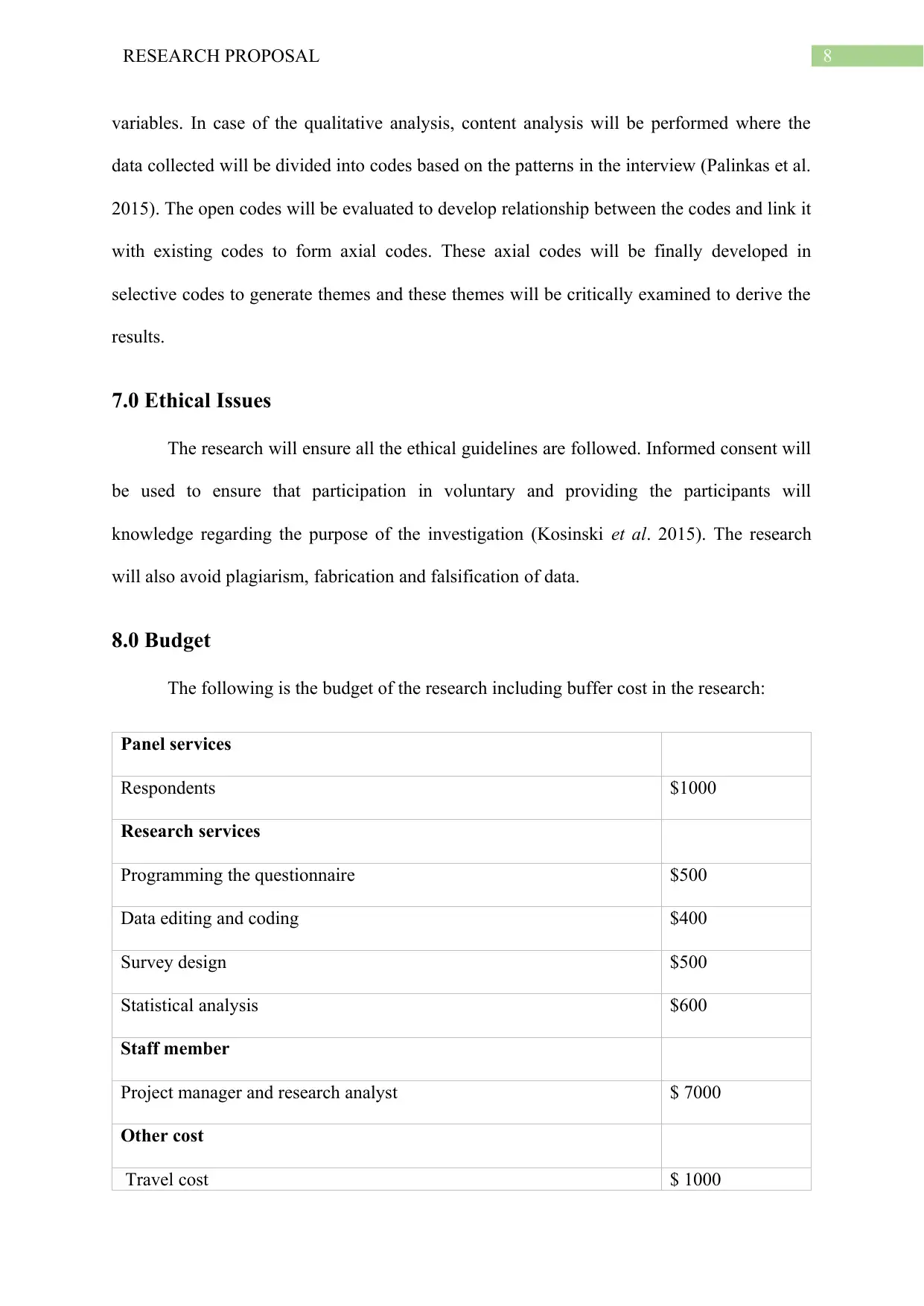
8RESEARCH PROPOSAL
variables. In case of the qualitative analysis, content analysis will be performed where the
data collected will be divided into codes based on the patterns in the interview (Palinkas et al.
2015). The open codes will be evaluated to develop relationship between the codes and link it
with existing codes to form axial codes. These axial codes will be finally developed in
selective codes to generate themes and these themes will be critically examined to derive the
results.
7.0 Ethical Issues
The research will ensure all the ethical guidelines are followed. Informed consent will
be used to ensure that participation in voluntary and providing the participants will
knowledge regarding the purpose of the investigation (Kosinski et al. 2015). The research
will also avoid plagiarism, fabrication and falsification of data.
8.0 Budget
The following is the budget of the research including buffer cost in the research:
Panel services
Respondents $1000
Research services
Programming the questionnaire $500
Data editing and coding $400
Survey design $500
Statistical analysis $600
Staff member
Project manager and research analyst $ 7000
Other cost
Travel cost $ 1000
variables. In case of the qualitative analysis, content analysis will be performed where the
data collected will be divided into codes based on the patterns in the interview (Palinkas et al.
2015). The open codes will be evaluated to develop relationship between the codes and link it
with existing codes to form axial codes. These axial codes will be finally developed in
selective codes to generate themes and these themes will be critically examined to derive the
results.
7.0 Ethical Issues
The research will ensure all the ethical guidelines are followed. Informed consent will
be used to ensure that participation in voluntary and providing the participants will
knowledge regarding the purpose of the investigation (Kosinski et al. 2015). The research
will also avoid plagiarism, fabrication and falsification of data.
8.0 Budget
The following is the budget of the research including buffer cost in the research:
Panel services
Respondents $1000
Research services
Programming the questionnaire $500
Data editing and coding $400
Survey design $500
Statistical analysis $600
Staff member
Project manager and research analyst $ 7000
Other cost
Travel cost $ 1000
⊘ This is a preview!⊘
Do you want full access?
Subscribe today to unlock all pages.

Trusted by 1+ million students worldwide

9RESEARCH PROPOSAL
Total $11,000
Total $11,000
Paraphrase This Document
Need a fresh take? Get an instant paraphrase of this document with our AI Paraphraser
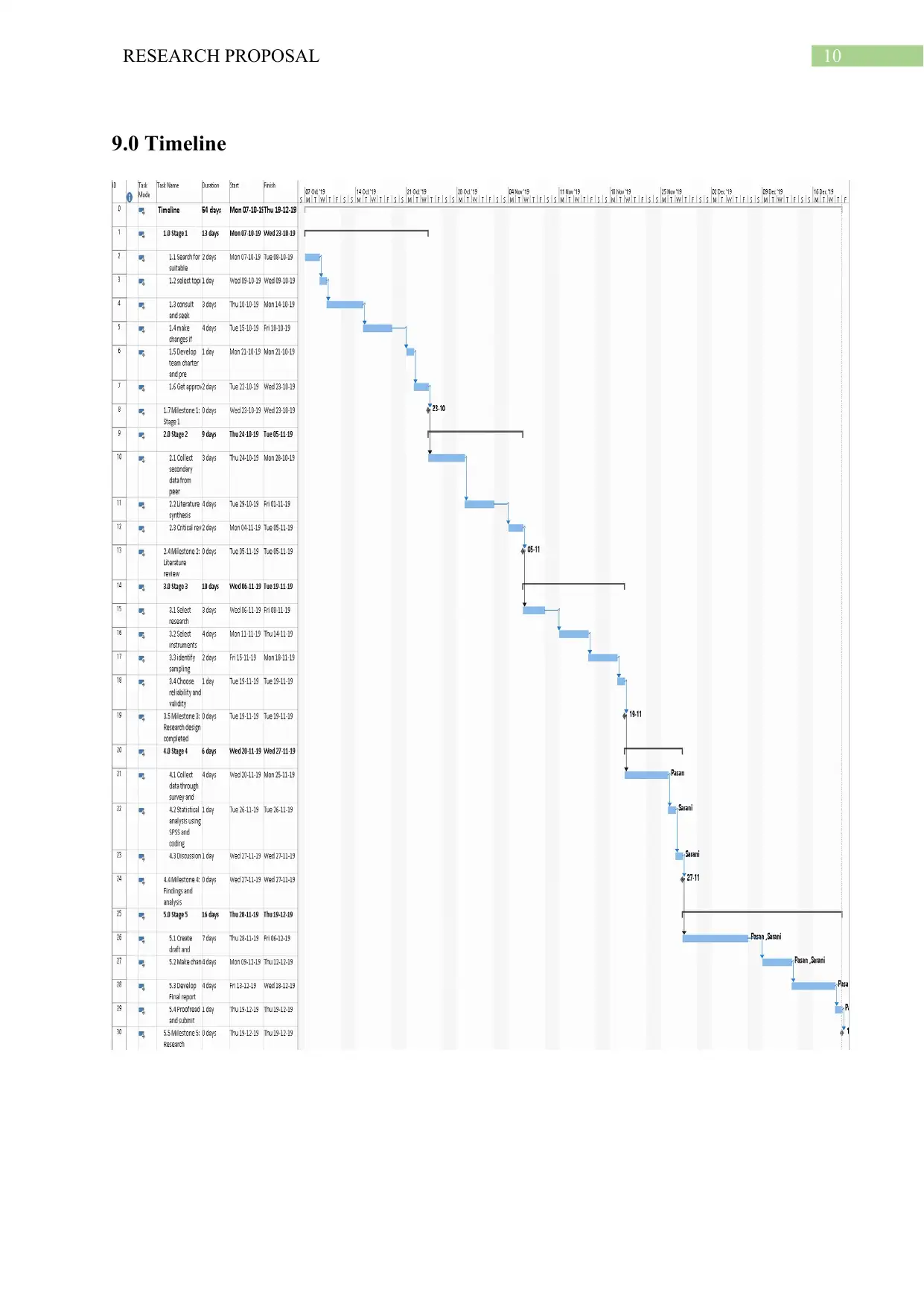
10RESEARCH PROPOSAL
9.0 Timeline
9.0 Timeline
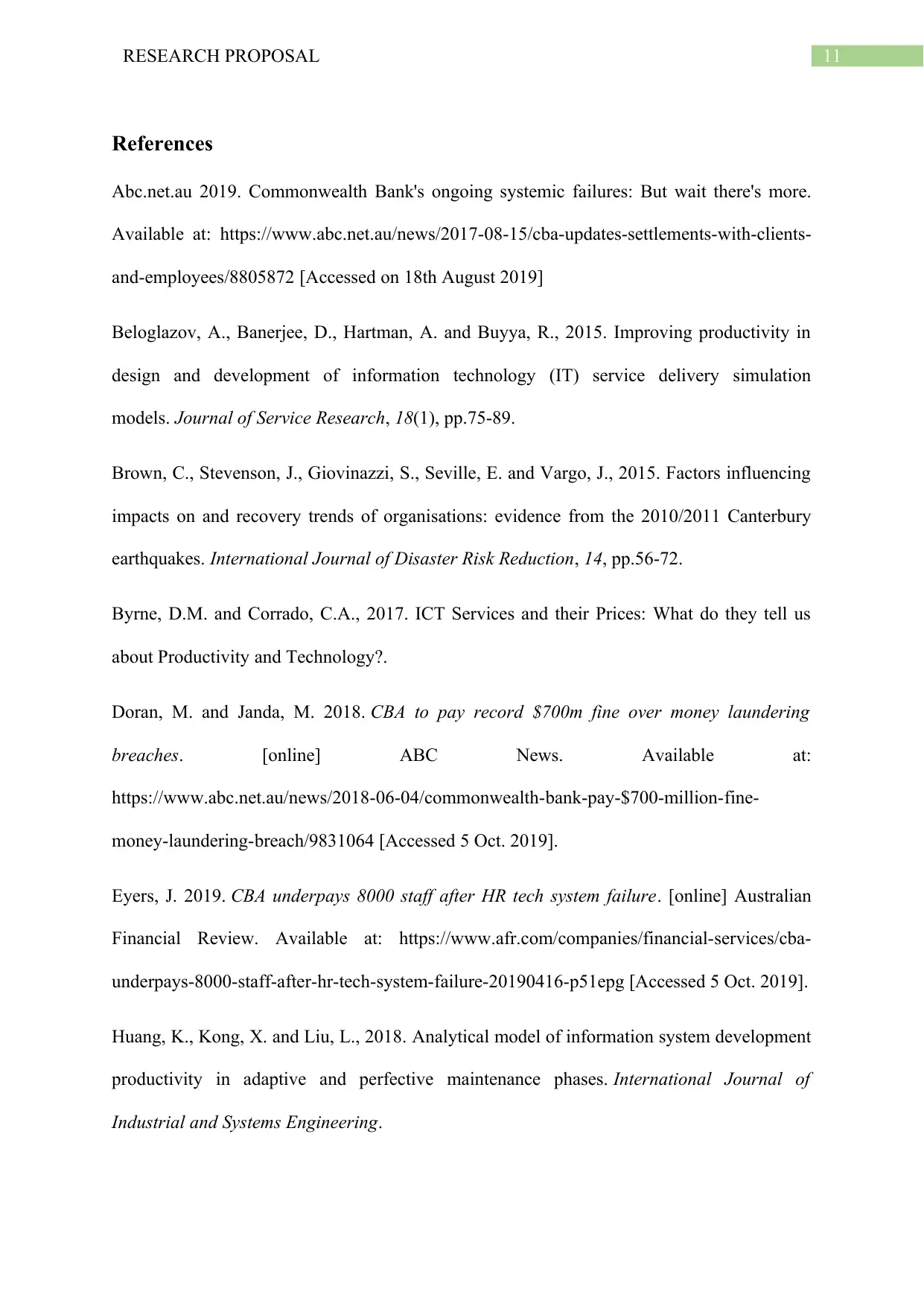
11RESEARCH PROPOSAL
References
Abc.net.au 2019. Commonwealth Bank's ongoing systemic failures: But wait there's more.
Available at: https://www.abc.net.au/news/2017-08-15/cba-updates-settlements-with-clients-
and-employees/8805872 [Accessed on 18th August 2019]
Beloglazov, A., Banerjee, D., Hartman, A. and Buyya, R., 2015. Improving productivity in
design and development of information technology (IT) service delivery simulation
models. Journal of Service Research, 18(1), pp.75-89.
Brown, C., Stevenson, J., Giovinazzi, S., Seville, E. and Vargo, J., 2015. Factors influencing
impacts on and recovery trends of organisations: evidence from the 2010/2011 Canterbury
earthquakes. International Journal of Disaster Risk Reduction, 14, pp.56-72.
Byrne, D.M. and Corrado, C.A., 2017. ICT Services and their Prices: What do they tell us
about Productivity and Technology?.
Doran, M. and Janda, M. 2018. CBA to pay record $700m fine over money laundering
breaches. [online] ABC News. Available at:
https://www.abc.net.au/news/2018-06-04/commonwealth-bank-pay-$700-million-fine-
money-laundering-breach/9831064 [Accessed 5 Oct. 2019].
Eyers, J. 2019. CBA underpays 8000 staff after HR tech system failure. [online] Australian
Financial Review. Available at: https://www.afr.com/companies/financial-services/cba-
underpays-8000-staff-after-hr-tech-system-failure-20190416-p51epg [Accessed 5 Oct. 2019].
Huang, K., Kong, X. and Liu, L., 2018. Analytical model of information system development
productivity in adaptive and perfective maintenance phases. International Journal of
Industrial and Systems Engineering.
References
Abc.net.au 2019. Commonwealth Bank's ongoing systemic failures: But wait there's more.
Available at: https://www.abc.net.au/news/2017-08-15/cba-updates-settlements-with-clients-
and-employees/8805872 [Accessed on 18th August 2019]
Beloglazov, A., Banerjee, D., Hartman, A. and Buyya, R., 2015. Improving productivity in
design and development of information technology (IT) service delivery simulation
models. Journal of Service Research, 18(1), pp.75-89.
Brown, C., Stevenson, J., Giovinazzi, S., Seville, E. and Vargo, J., 2015. Factors influencing
impacts on and recovery trends of organisations: evidence from the 2010/2011 Canterbury
earthquakes. International Journal of Disaster Risk Reduction, 14, pp.56-72.
Byrne, D.M. and Corrado, C.A., 2017. ICT Services and their Prices: What do they tell us
about Productivity and Technology?.
Doran, M. and Janda, M. 2018. CBA to pay record $700m fine over money laundering
breaches. [online] ABC News. Available at:
https://www.abc.net.au/news/2018-06-04/commonwealth-bank-pay-$700-million-fine-
money-laundering-breach/9831064 [Accessed 5 Oct. 2019].
Eyers, J. 2019. CBA underpays 8000 staff after HR tech system failure. [online] Australian
Financial Review. Available at: https://www.afr.com/companies/financial-services/cba-
underpays-8000-staff-after-hr-tech-system-failure-20190416-p51epg [Accessed 5 Oct. 2019].
Huang, K., Kong, X. and Liu, L., 2018. Analytical model of information system development
productivity in adaptive and perfective maintenance phases. International Journal of
Industrial and Systems Engineering.
⊘ This is a preview!⊘
Do you want full access?
Subscribe today to unlock all pages.

Trusted by 1+ million students worldwide
1 out of 13
Related Documents
Your All-in-One AI-Powered Toolkit for Academic Success.
+13062052269
info@desklib.com
Available 24*7 on WhatsApp / Email
![[object Object]](/_next/static/media/star-bottom.7253800d.svg)
Unlock your academic potential
Copyright © 2020–2025 A2Z Services. All Rights Reserved. Developed and managed by ZUCOL.





